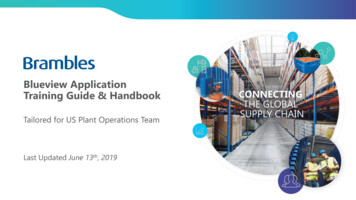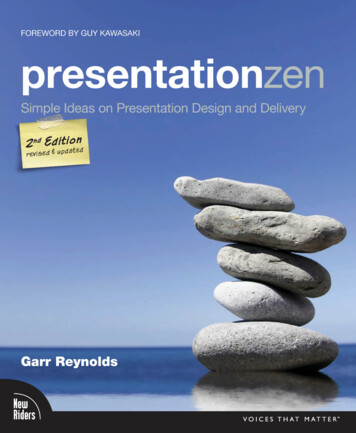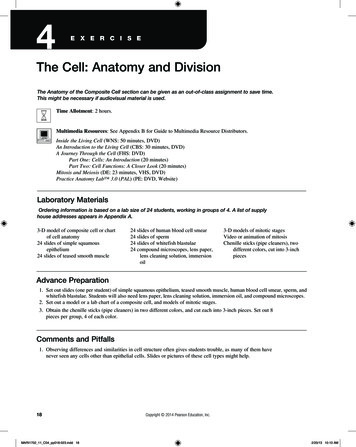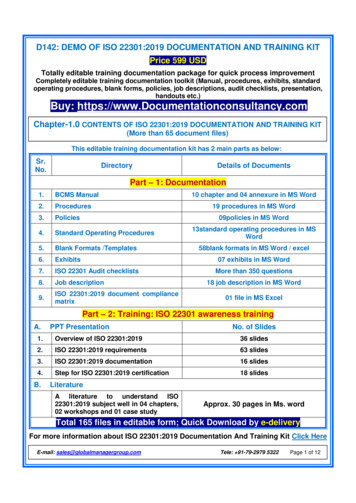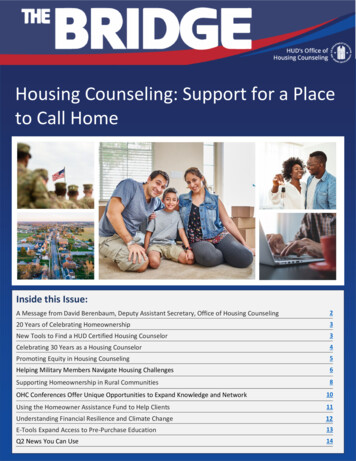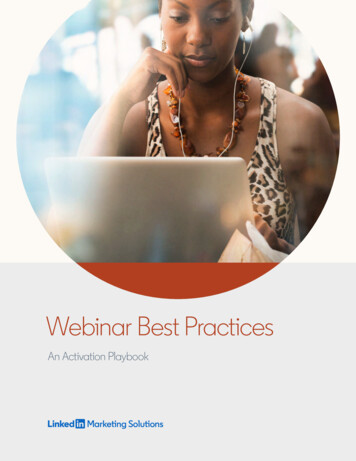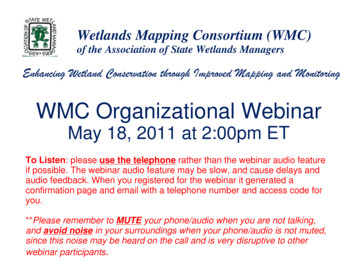
Transcription
How the Homeowner Assistance Fund (HAF)Can Serve Your ClientsOffice of Housing CounselingU.S. Department of Housing and Urban DevelopmentMarch 1, 2022
Questions? Participants are in listen only mode Chato Submit any technical issues via the Chatbox Send the message to the Host Q&Ao Submit any content related questions viathe Q&A box Send to Host, Presenter, and Panelists2
Get Credit! The PowerPoint is available today and thelink will be provided in the chat box Remaining webinar materials will beposted on the HUD Exchange in theWebinar Archiveo Find by date or by topicTo obtain credito Select the webinar, and click“Get Credit for this Training”3
Housing Counseling Training Digest Visit the Training Digest on the HUD Exchange View upcoming training hosted by HUDand other partners4
Polling There will be polling provided in Mentimeter throughout this presentation.When prompted by the icon to the right, please respond to questions atwww.menti.com using your computer or smart phone.Time forMentimeter!5
David BerenbaumDeputy Assistant SecretaryOffice of Housing Counseling (OHC)
Facilitators & Presenters Facilitators: Karen Hoskins and Shawna LaRue Moraille, ICF, HUD TA Providers Speakers: William Corbett and Patrick Orr, U.S. Department of Treasury Julienne Joseph, the Deputy Assistant Secretary for FHA Single Family Housing, Federal HousingAdministration (FHA) Paul O’Leary, Freedom Mortgage Greg Zagorski and Rosemarie Sabatino National Council of State Housing Agencies (NCSHA) Jaime Rice, Kentucky Housing Corporation (KHC) Stephanie Stiene, Brighton Center Mark McArdle, Consumer Finance Protection Bureau (CFPB)7
Agenda Overview of the HAF Program How HAF Can Benefit FHA Borrowers Panel Resources Q and A8
Overview of the HAF Program
U.S. DEPARTMENT OF THE TREASURYAN OVERVIEW OFHomeowner Assistance FundFebruary 202210
11DisclaimerThis presentation is designed to give an overview of the Homeowner Assistance Fund programfor educational purposes. It should not be construed as legal advice or a statement of bindingpolicy guidance from the Treasury.For official Treasury guidance, go to: www.Treasury.gov/HAF11
12Homeowner Assistance FundOverviewThe American Rescue Plan Act makes 9.96B in Homeowner Assistance Funds (HAF) available tostates, the District of Columbia, U.S. territories, Tribes or Tribal entities, and the Department ofHawaiian Home Lands to aid households struggling to pay mortgages and utilities.Part of a broad response to coronavirus-related housing risks across all of government.Key objectives of HAF: Prevent mortgage delinquencies and defaults, foreclosures, loss of utilities or home energy services,and displacement of homeowners experiencing financial hardship after January 21, 2020. Provide funds for mortgage payments, homeowner’s insurance, utility payments, and other specifiedpurposes. Requires at least 60% of funds go to homeowners with income at or below 100% AMI or US MI tocover qualified expenses; prioritization of remaining funds for socially disadvantaged individuals.12
13Other HAF HighlightsTargeting 60% of each Participant’s HAF Funds to assist homeowners having income 100% of area median income or 100% of U.S.median income, which is greater Any amount not made available to homeowners that meet this income-targeting requirement must be prioritized for assistanceto socially disadvantaged individuals, with funds remaining after such prioritization being made available for other eligiblehomeowners.HAF Eligibility Homeowners are eligible to receive amounts allocated to a HAF participant under the HAF ifo They experienced a financial hardship after January 21, 2020 (including a hardship that began before January 21, 2020, butcontinued after that date) ando Have incomes equal to or less than 150% of the area median income or 100% of the median income for the United States,whichever is greater. A HAF participant may provide HAF funds only to a homeowner with respect to qualified expenses related to the homeowner’sprimary residence.HAF Counseling/Legal Services Resources Up to 5% of HAF participants funding may be used for counseling or educational efforts by housing counseling agenciesapproved by HUD or a tribal government, or legal services, targeted to households eligible to be served with funding from theHAF related to foreclosure prevention or displacement.13
14Helping Homeowners: Qualified ExpensesEligible expenses may vary depending upon the HAF participant’s program design.In general, HAF funds may be used for the following:Mortgage Assistance Payment assistance Reinstatement of mortgage or other housing-related costs Principal reduction Facilitating interest rate reductionsOther Payment assistance for Delinquent property taxes to prevent tax foreclosure Utilities, Energy, and Broadband Internet Homeowner’s insurance, flood insurance, and mortgage insurance Homeowner’s association fees or liens, condominium association fees, or common charges Down payment assistance loans provided by nonprofit or government entitiesOther Measures to Prevent Displacement Repairs to maintain a home’s habitability or assistance to enable households to obtain clear title to their properties.14
15HAF Plan Review Process Initial funding, nearly 1 billion total, allowed participants to set up their programsand begin providing immediate assistance to homeowners in need. Treasury designed the HAF program approval process, based on feedback fromadvocates and experts and experience with past programs. Performance Plan entities, plus counties and metropolitan cities with fewer than 250,000residents but greater allocations than 5M, account fo1,661 counties and metropolitan cities fall 5MStates submitted plans, received feedback from Treasury, and then revisedbelowplans based on feedback, experience with pilots, and input from community. As a result, these revised plans will better ensure these funds are distributedequitably and reach underserved communities.15
16For More Information:Thank you.Please visit Treasury’s HAF website atwww.Treasury.gov/HAFFor Media Inquiries:Please contact the U.S. Treasury Press Officeat press@treasury.gov.16
How HAF Can BenefitFHA Borrowers
Panel DiscussionTime forMentimeter!
Panelists Greg Zagorski and Rosemarie Sabatino National Council of State Housing Agencies(NCSHA) Jaime Rice, Kentucky Housing Corporation (KHC) Stephanie Stiene, Brighton Center19
HAF: A NationalOverviewPresented by Greg Zagorski and Rosemarie Sabatino20
The National Council of State Housing Agencies Nonprofit, nonpartisan organization created by the nation's state HousingFinance Agencies (HFAs). Represents the HFAs for all 50 states, DC, Puerto Rico, the U.S. Virgin Islands,and New York City. Out of the 56 agencies administering HAF, 42 are HFAs The principal advocate in Washington for both tax exempt SF and MF housingbonds and the LIHTC and the principal state advocate for HOME. Mission Statement:“To advance through advocacy and education the nation's state HousingFinance Agencies' efforts to provide affordable housing to those who need it.”21
Program Status States were tasked with using HAF to meet the needs of their state/territory As of February 23, 2022: Most state/territory HAF Plans approved by Treasury 23 programs launched state/territory-wide 10 pilots underway Key steps undertaken by HAF Agencies to prepare: Creating a portal for homeowners to register to receive information once HAFprogram launched (most states) Reaching out to housing counselors, legal advisors, and other resourceshomeowners might connect to for advice/assistance Signing up servicers and establishing a secure way of communicating PII ofhomeowners Reaching out to utilities, local tax jurisdictions, etc.22
HAF Programs: Single-Family HomesIn addition to 1–4-unit SF properties, different HAF programs will serve varioustypes of single-family housing:Percentage of States Allowing These Housing TypesManufactured/mobile homeLand leases (e.g. land contracts, contracts fordeed)Condo unitsCoop units0%10%20%30%40%50%60%70%80%90% 100%23
HAF AssistanceThe type of HAF assistance varies by state:Percentage of States Offering HAF As:GrantForgivable loan that is recorded;recapture/repayment possibleOther0%10%20%30%40%50%60%70%80%90%24
HAF AssistanceThe type of mortgage assistance varies by state:Percent of States Offering Certain Mortgage %ReinstatementProgramOn-going mortgagepayment assistanceLoan mods with HAF Post-loss mit principal Partial Claim/Deferredcontributionreduction & recast (ifPayment pay-offpossible)25
HAF AssistanceThe expenses eligible for assistance varies by state:The Number of States Offering These Types of Assistance:Housing CounselingProperty repairs/habitabilityProperty taxes (outside of those escrowed by servicer)HOA/Condo feesHomeowner's insurances (outside of those escrowed by servicer)Broadband/internetUtility AssistanceMortgage Assistance0510152025303540455026
HAF Programs Across the Country - EnglishVisit NCSHA’s HAF webpage.27
HAF Programs Across the Country - fund/espanol/28
Kentucky’s HomeownerAssistance FundPresented By:Jaime W. Rice, Managing Director of Single-Family Programs
Kentucky’s Homeowner Assistance Fund 85.4 MillionKentucky homeowners are eligible to receive up to 35,000 in assistanceas a non-recourse grant.Qualifying Expenses:1. Mortgage reinstatement2. Monthly mortgage payment assistance, up to 6 months3. Past due Non-escrowed Property Taxes (up to 3 years)4. Past due Non-escrowed Insurance (Homeowner’s and/or flood)5. Past due Homeowner’s Association Fees6. Past due Utilities (Gas, Water/ Sewer, Electric)30
Homeowner Assistance FundProcess Homeowners apply through the www.ProtectMyKYHome.org.– Online application portal and document upload. Homeowners are assigned to a partner housing counseling agency. The housing counselors will work with the homeowners tocomplete the application process. We underwrite, close, and process payments.31
Kentucky’s Homeowner Assistance FundPartnering with Housing CounselorsHousing counselors are better trained to address financial barriersfaced by our homeowners.1. They help homeowners with the HAF application process.2. They help homeowners with the loss mitigation process.3. They help with budget/financial education.4. They help with transitional counseling when retention is not anoption.Housing Counselors are the key partner!32
Kentucky’s Homeowner Assistance FundPilot Phases11/8/2021: Test PilotFull Program Launched 2/7/2022– 30 KHC mortgagors rolling out of FHA COVIDforbearance plans. – Only 7 applications for HAF. 11/22/2021: Test Pilot II– 127 KHC mortgagors rolling out of COVID forbearanceplans that month. Governor’s office issued press release announcingour program launchKHC notified over 11,000 listserv registrants thatour program was live.Approximately 2,000 applications initiated.12/22/2021: Full Pilot– Remaining 800 KHC mortgagors in COVIDforbearance plans.– Housing Counselors started receiving referrals. COVID Loss Mit training for Counselors on 12/10/202133
Kentucky’s Homeowner Assistance FundKnow Your Options34
Kentucky’s Homeowner Assistance FundConozca sus opciones35
Homeowner Assistance FundKnow Your Options, ContinuedIt is critical that homeowners know their options. Not only does KHC provide the direct video,but we also:1.Homeowner Disclosure on the first screen of their applications.2.The counselors likewise certify the following before submitting a file for underwriting:I, the housing counselor assigned to this case, have discussed with the homeowner(s) that theHomeowner Assistance Fund is a one-time benefit. The better options for long-term sustainability ofthe mortgage may be with the mortgage servicer’s loss mitigation options. The homeowner haseither exhausted those options, are not eligible for those options, has opted to bypass thoseoptions, or their servicer does not offer loss mitigation based on the type of mortgage. Thehomeowner(s) wish(es) to proceed with the Homeowner Assistance Fund application.36
Homeowner Assistance FundKnow Your Options, Continued37
Brighton Center, Inc.Stephanie StieneFinancial Wellness and Volunteer Engagement Director
Housing Counselors Key to Success Offering Loss Mitigation services to support homeowners whohave fallen behind in their payments. Learning about the Homeowner Assistance Fund offered inyour state. Supporting homeowners with a referral or helping them apply. Discussing transition if retention is not an option.39
Building Capacity and Managing Expectations Clear messaging – website, email, timelinesLearn as much about the application process as possibleIdentify / Eliminate potential barriersKnowledge of wrap-around supportsVolunteersSelf-care40
Resources and Q and A
Office of Housing Counseling Foreclosure Prevention COVID-19 Emergency Information for HousingCounselors COVID-19 Relief Chart, including HAF Find us at: www.hudexchange.info/counseling The Bridge Newsletter Email us at: Housing.counseling@hud.gov42
CFPB Resources Homeowner Assistance Fund homeowners/get-homeowner-assistancefunds/ Link to consumerfinance.gov/housing on your organization’s website Use our Digital Toolkit: g-assistance/housing-insecurity-media-toolkit/ Submit a Complaint: https://www.consumerfinance.gov/complaint/43
Office of Housing CounselingU.S. DEPARTMENT OF HOUSING AND URBAN DEVELOPMENTThank You For Attending!
HAF Counseling/Legal Services Resources Up to 5% of HAF participants funding may be used for counseling or educational efforts by housing counseling agencies approved by HUD or a tribal government, or legal services, targeted to households eligible to be served with funding from the HAF related to foreclosure prevention or displacement. 13
